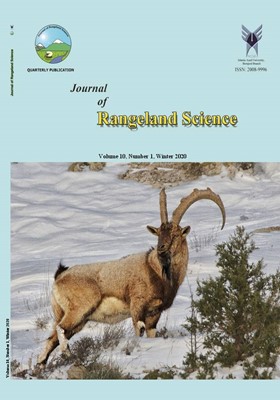Soil Salinity Mapping Based on ETM+ Data in Arid Rangeland, Iran (Case Study: Damghan Region, Iran)
محورهای موضوعی : Remote Sensing (RS)
Mitra Shirazi
1
,
Ali Akbar Damavandi
2
![]()
1 - Ph.D. in Combat Desertification, Yazd University, Yazd, Iran
2 - Agricultural Research, Education and Extension Organization (AREEO), Tehran, Iran
کلید واژه: PCA, ETM+, remote sensing, Soil Indices,
چکیده مقاله :
Soil salinity has concerned people in arid and semi-arid rangelands. One of the most essential cases in relation to information for natural resource managers is preparation of soil salinity maps. Developing such maps, using traditional methods spends a lot of time and costs. Satellite data have broadened and integrated our vision for this purpose. This study was conducted in order to develop a model for providing a salinity map using ETM+ satellite data collected in 2012 and salinity values in Damghan rangelands, Iran. The geometric and atmospheric correction of satellite images was carried out. Necessary processing such as fusion of multispectral bands with panchromatic bands, tasseled cap transformation, the analysis of Principal Components Analysis (PCA), and rationing for composite bands creation were also performed. A total number of 114 surface soil sample points with the depth of 0-15 cm were taken through a random sampling method and their Electrical Conductivity (EC) was measured. Different bands extracted spectral values for each sample and the relation between spectral values (i.e. main bands, Tasseled Cap bands, and soil and vegetation index) with EC values of the samples was investigated. Using PCA analysis, the variables were categorized into four principle components to develop soil EC map according to the highest correlation. Results revealed that there was the highest correlation between PCA1 and variables of blue, green, red bands (R=0.7), Tasseled cap 1, 2, 4 (R=0.68) and indicators SI1, SI2, SI3 (R=0.7), GVI, BI (R=0.68), INT1, INT2, MND, WDVI (R=0.7). In PCA2, the variables of NIR,OSAVI, NDVI, SAVI, VNIR1 and TVI had a significant correlation with PCA2. Finally, using stepwise regression, three models were developed to determine soil salinity maps according to the utilized independent variables. Results showed that Landsat ETM+ images are good tools to estimate salinity maps of arid rangelands.
Abarsaji, GH.A. Mahdavi, M.,Jouri,Mohammad Hassan., 2011. Determination of Soil Salinity in Frankenia hirsutaL. Habitat (Case Study: Saline and Alkaline Rangelands of Golestan Province), Journal of Rangeland Science, 2012, Vol. 2, No. 2.
Abdelfattah, M.A., Shahid, S.A., Othman, Y.R., 2009. Soil salinity mapping model developed using RS and GIS: a case study from Abu Dhabi, United Arab Emirates. Eur. J. Sci. Res. 26, 342–351.
Abdi Naam, A. 2004. An investigation on preparing of the soil salinity map using correlation method between imagery and soil salinity data in the Qazvin plain, Iran. Journal of Pazhouhesh and Sazandegi, 64: 33-38. (In Persian).
Akhzari,D., Ildoromi,A.,Dashti,M.M.,2013. Effects of Salinity on Seedling Growth and PhysiologicalTraits of Vetiver Grass (Vetiveria zizanioidesStapf), Journal of Rangeland Science, Vol. 3, No. 3.
Alavipanah, S.K. 2003. Application of remote sensing in the earth science (soil), Tehran Univ. Press, first edition, 462p. (In Persian).
Amini, M. 1999. Geostatistical assessment of soil salinity and alkalinity in selected soils from Rudasht area, M.Sc. thesis of pedology, Isfahan University of technology, College of Agriculture, Department of Soil Science, 119p. (In Persian).
Bahtti, A.U., Mulla, D.J. and Frazier, B.E. 1991. Estimation of soil properties and wheat yields on complex eroded hills using geostatistics and thematic mapper images. Remote Sens. Environment, 37: 181-191.
Chitsaz, V. 1999. Investigation of possibility of soil salinity & alkalinity map producing using TM data in eastern Isfahan, a thesis of presented for M.Sc. Isfahan University of technology, Faculty of Natural Resources, 135p. (In Persian).
Chitsaz, V., and Khajeddin, S.J. 2000. Mapping of soil salinity and alkalinity using remotely sensed data of TM in eastern of Isfahan. Proceeding of Geomatic Congress, Tehran, Iran. Pp: 156-167. (In Persian).
Darvishsefat, A. 2002. Incorporating of remotely sensed data. Proceeding of Geomatic Congress. National Cartographic Center, Tehran. (In Persian).
Dwivedi, R. S. 2006. Study of salinity and waterlogging in Uttar Pradesh (India) using remote sensing data. Land Degradation & Development, 5: 191–199.
Fernandez-Buces, N., Siebe, C., Cram, S., and Palacio, J.L. 2006. Mapping soil salinity using a combined spectral response index for bare soil and vegetation: (a case study in the former lake Texcoco, Mexico), J. Arid Environments, 65: 644-667.
Goldshleger, N., Ben-Dor, E., Benyamini, Y., and Agassi, M. 2004. Soil reflectance as a tool for assessing physical crust arrangement of four typical soils in Israel. Soil Science, 169: 10. 677-687.
Jafari Gorzin, B. 2002. Study of landsat ETM+ capability in detecting salt affected lands (a case study in Gorgan Plain), a thesis of presented for M.Sc. Gorgan university of Agriculture and Natural Resource Science, college of Range and Watershed Management, 127p.
Khajeddin, S.J. 1998. Use of MSS5 satellite data in investigation of vegetation types and saline soils of Jazmourian. P 41-48, Proceeding of 2nd National to Combat Desertification. Forestry and Rangeland Organization. Teheran, Iran. (In Persian).
Metternicht, G.I., Zinck, J.A., 2003. Remote sensing of soil salinity: potentials and constraints. Remote Sens. Environ. 85, 1–20.
Noroozi, A.A., Homaii, M., 2013. Estimating soil surface using satellite images Landsat: comparison of classical statistical models and spatial statistics, Range & Watershed Journal 609-620:4. (In Persian).
Rivero, R.G., Grunwald, S. and Bruland. G.L. 2007. Incorporation of spectral data into multivariate geostatistical models to map soil total phosphorus variability in a Florida wetland. Geoderma 140:428–433. doi:10.1016/j.geoderma.2007.04.026
Saxsena, R.K., K.S.Verma, R. Srivastava, J.Y., Patel, N.K., Nasre, R.A., Barthwal, A.K., Shiwalkar, A.A., and Londhe, S.L. 2003. Spectral reflectance properties of some dominant soils occurring on different altitudinal zones in Uttaranchal Himalayas. Agropedology, 13: 2. 35-43.


